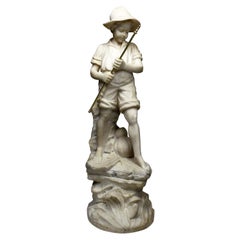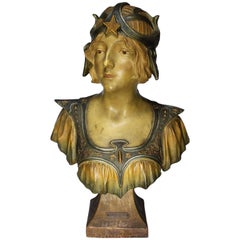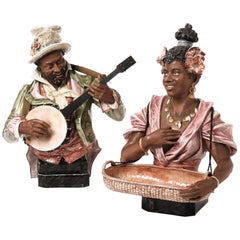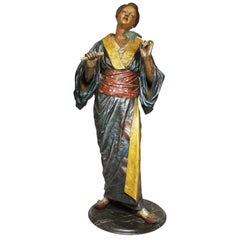Want more images or videos?
Request additional images or videos from the seller
1 of 10
Charming Pair of Austrian 19th Century Polychromed Majolica Wall Sculptures
Price:$6,895
About the Item
- Attributed to:Friedrich Goldscheider (Manufacturer)
- Dimensions:Height: 16.5 in (41.91 cm)Width: 13.75 in (34.93 cm)Depth: 8.5 in (21.59 cm)
- Sold As:Set of 2
- Style:Baroque (In the Style Of)
- Materials and Techniques:Majolica,Polychromed
- Place of Origin:
- Period:
- Date of Manufacture:circa 1890-1900
- Condition:Wear consistent with age and use. Good antique condition with minor wear and old paint chippings (see images). Unlike others similar, these pair is one of the earliest and finest majolica sculptures with fine attention to detail.
- Seller Location:Los Angeles, CA
- Reference Number:Seller: Ref.: A15831stDibs: LU179625437473
About the Seller
5.0
Vetted Professional Seller
Every seller passes strict standards for authenticity and reliability
Established in 1982
1stDibs seller since 2016
135 sales on 1stDibs
Authenticity Guarantee
In the unlikely event there’s an issue with an item’s authenticity, contact us within 1 year for a full refund. DetailsMoney-Back Guarantee
If your item is not as described, is damaged in transit, or does not arrive, contact us within 7 days for a full refund. Details24-Hour Cancellation
You have a 24-hour grace period in which to reconsider your purchase, with no questions asked.Vetted Professional Sellers
Our world-class sellers must adhere to strict standards for service and quality, maintaining the integrity of our listings.Price-Match Guarantee
If you find that a seller listed the same item for a lower price elsewhere, we’ll match it.Trusted Global Delivery
Our best-in-class carrier network provides specialized shipping options worldwide, including custom delivery.You May Also Like
Delft Polychrome Enameled Earthenware Parrot, 18th-19th Century
Located in Amsterdam, NL
A fabulous polychrome enameled earthenware parrot
Delft or France, 18th or 19th century
Suspended from a ring, with modern powder-coated stand.
Measure: L parrot 26 cm.
Category
Antique 19th Century Dutch Ceramics
Materials
Earthenware
$5,415
Free Shipping
H 10.24 in W 5.91 in D 5.91 in
Ceramic Sculpture with a Group of Playing Putti's 19th Century Belgium
Located in Antwerp, BE
Beautiful in detail and charming 19th century unglazed terracotta sculpture. Features a design of three cherubic children with lamps and fruit, playing with two goats on the base of ...
Category
Antique 1890s Belgian Folk Art Figurative Sculptures
Materials
Terracotta
$1,444 Sale Price
20% Off
H 12.6 in W 18.9 in D 5.91 in
19th Century Large Staffordshire Cottage
Located in High Point, NC
19th century large Staffordshire cottage with very interesting design. It has many levels and interesting architectural details, accented with h...
Category
Antique 19th Century English Victorian Figurative Sculptures
Materials
Ceramic
19th Century Staffordshire Cottage Bank
Located in High Point, NC
19th century Staffordshire pottery penny bank from England in the form of a cottage with flocked details. The coin slot has a few nicks from age and use.
Category
Antique 19th Century English Victorian Ceramics
Materials
Pottery
Pair of Majolica Ceramic Pelican Birds in Yellow Cream and Black, a Pair
Located in Oklahoma City, OK
A pair of tall handmade hand-painted ceramic majolica pelican birds. Each bird is glazed in cream, yellow and black. This pair will be fabulous to display on a bookshelf or foyer tab...
Category
20th Century American Hollywood Regency Animal Sculptures
Materials
Ceramic, Paint
$440 Sale Price / set
20% Off
H 10 in W 3.5 in D 7 in
Pair of Mid Century 1950s Howard Pierce Ceramic Quail Bird Sculpture Figurine
Located in San Diego, CA
Iconic pair of Howard Pierce ceramic quail bird figurines/sculptures dating from the 1950s. These are an iconic design. Great color and form. The larger ...
Category
Mid-20th Century Animal Sculptures
Materials
Ceramic
$220 Sale Price / set
20% Off
H 5.75 in W 5 in D 3 in
19th Century Polychrome Sculpture of a Roman Woman
Located in Haddonfield, NJ
Italian original painted plaster sculpture of a young Roman woman in nice gilt dress and flower wreath. This well sculptured smiling lady cou...
Category
Antique 1880s Italian Neoclassical Animal Sculptures
Materials
Plaster
Italian Large Majolica Terracotta Sculpture with Lustre by Adolfo Merlone, 1950s
Located in Morazzone, Varese
Italian Large Majolica Terracotta Sculpture with Lustre by Adolfo Merlone, 1950s
Majolica terracotta sculpture decorated with lustre glazes in shades of red, blue and yellow depicti...
Category
Vintage 1950s Italian Mid-Century Modern Abstract Sculptures
Materials
Maiolica, Terracotta
$3,128
H 25.6 in W 13.78 in D 6.7 in
Lucky Horn Ceramic Sculpture Glazed Majolica Platinum Gold Hand Painted, Italy
Located in London, GB
Francesco Raimondi, Lucky Horn, 2020 glazed earthenware, platinum and gold, hand painted, unique piece
Measures: Approximate 100cm x 25 cm
A cornicello It...
Category
21st Century and Contemporary Italian Renaissance Revival Abstract Sculp...
Materials
Platinum, Gold
$7,499 Sale Price
20% Off
H 39.38 in Dm 9.85 in
Paul Soldner Large Mid-Century Pottery Raku Slab Charger Wall Relief Sculpture
By Paul Soldner
Located in Studio City, CA
An amazing and unique piece by renowned American pottery and ceramic master Paul Soldner who in the 1950s was Peter Voulkos' first student and who later became famed for developing the technique now known as "American Raku...
Category
20th Century American Mid-Century Modern Ceramics
Materials
Earthenware
$2,995
H 14.5 in W 16 in D 3.5 in
More From This Seller
View AllCharming Italian 19th-20th Century Carved Alabaster Figure of a Fisher Boy
Located in Los Angeles, CA
A charming Italian 19th-20th century carved alabaster figure of a fisher boy. The young boy wearing a blouse, with his pant legs rolled up to his knees and ...
Category
Antique Early 1900s Italian Country Figurative Sculptures
Materials
Alabaster
$3,795 Sale Price
20% Off
French 19th-20th Century Art Nouveau Polychromed Terracotta Bust of "Crépuscule"
By Salesio Lugli
Located in Los Angeles, CA
A fine French 19th-20th century Art Nouveau polychromed terracotta bust of "Crépuscule" (Twilight) After Henri Jacobs (Belgian, 1864-1935) version of Crépuscule, depicting a young ma...
Category
Antique Early 1900s French Art Nouveau Busts
Materials
Terracotta
$4,750 Sale Price
26% Off
Pair 19th-20th Century Majolica Busts of "the Banjo Player and the Flower Lady"
By GOLDSCHEIDERSCHE PORZELLAN-MANUFACTUR UND MAJOLICA-FABRIK (1885-1953)
Located in Los Angeles, CA
A Very Fine and Rare Pair of 19th-20th Century Majolica busts of "The Banjo Player and The Flower Lady," probably Austrian Goldscheider, each depicting an ...
Category
Antique Early 1900s Austrian Other Busts
Materials
Terracotta
$18,950 Sale Price / set
57% Off
French 19th Century Polychromed Life-Size Figure of a Geisha, Charles Massé
By Charles Masse
Located in Los Angeles, CA
A fine French 19th century Polychromed Japonisme life-size cast-metal figure of a standing Geisha, cast after a model by Charles Massé (French, 1855-1913). The standing Japanese beau...
Category
Antique 19th Century French Japonisme Figurative Sculptures
Materials
Metal
$26,850 Sale Price
21% Off
Pair of French 19th/20th Century Patinated Bronze Sculptures "The Marly Horses"
By Guillaume Coustou
Located in Los Angeles, CA
A Fine Pair of French 19th/20th Century Patinated Bronze Sculptures of "The Marly Horses" After the original by Guillaume Coustou (French, 1677-1746). The large pair of equestrian br...
Category
Antique Early 1900s French Louis XV Figurative Sculptures
Materials
Bronze
Pair French 19th/20th Century Gilt-Bronze Sculptures of The Marly Horses Lamps
By Guillaume Coustou
Located in Los Angeles, CA
A Fine Pair of French 19th/20th Century Gilt-Bronze Sculptures of "The Marly Horses" (Now turned into lamps) After the original by Guillaume Coustou (French, 1677-1746). The large pair of equestrian bronze sculptures, finished in a gold patina, each depicting rearing horses with their groom, both raised on oval a black slate and Bardiglio marble bases and fitted with modern electrical twin-light brass fittings and cream colored shades. The base on an ebonized wooden platform. Circa: Paris, 1900-1920.
Sculpture & Base Height: 31 1/4 inches (79.8 cm)
Base Width: 21 3/4 inches (55.3 cm)
Base Depth: 12 3/4 inches (32.4 cm)
Height to top of (Adjustable) shade fitting: 48 1/4 inches (122.6 cm)
Shade Height: 15 inches (38.1 cm)
Shade Width: 26 inches (66.1 cm)
Shade Depth: 20 inches (50.8 cm)
The original Marly Horses are two 1743–1745 Carrara marble sculpted groups by Guillaume Coustou. They were commissioned by Louis XV of France for the trough at the entrance to the grounds of his château de Marly. Coustou's last works, they were intended to replace two other sculpted groups, Mercury on Pegasus and Pegasus, Renown of Horses, both by Antoine Coysevox, which had been removed to the Tuileries Gardens in 1719.
Louis XV chose the modellos in 1743 and the full-size sculptures were completed in only two years, being installed at Marly in 1745. They proved highly successful in reproduction, particularly on a smaller scale, and prefigured Théodore Géricault and other Romantic artists' obsession with equestrian subjects. The Marly horses were later also used as the central motif of the monochrome 819-line RTF/ORTF test card which was used on TF1 from 1953 until 1983.
The originals were moved to the place de la Concorde in Paris in 1794 and Louis-Denis Caillouette (1790–1868) restored them in 1840. In 1984 it was concluded that the annual military parades on 14 July were damaging the sculptures and they were replaced by marble copies produced by Michel Bourbon in the studio of a subsidiary of Bouygues. The latter also gained the right to an extra copy, which was placed in Bouygues's social building. The original sculptures were moved to a former courtyard in the Richelieu wing of the Louvre Museum, which was renamed the 'cour Marly' in their honour, whilst Bourbon's two main copies were moved to the originals' first site near the trough at Marly, with work overseen by the architect Serge Macel.
Guillaume Coustou the Elder (29 November 1677, Lyon – 22 February 1746, Paris) was a French sculptor of the Baroque and Louis XIV style. He was a royal sculptor for Louis XIV and Louis XV and became Director of the Royal Academy of Painting and Sculpture in 1735. He is best known for his monumental statues of horses made for the Chateau of Marly, whose replicas now stand in the Place de la Concorde in Paris.
Coustou was a member of a family of famous sculptors; his uncle, Antoine Coysevox, was a royal sculptor; his elder brother, Nicolas Coustou was a sculptor, and his son Guillaume Coustou the Younger also become a noted royal sculptor. Like his older brother, he won the (Prix de Rome) of the Royal Academy which entitled him to study for four years at the French Academy in Rome. However, he refused to accept the discipline of the academy, gave up his studies, set out to make his own career as an artist. He worked for a time in the atelier of the painter Pierre Legros, and eventually returned to Paris.
Upon his return to Paris, he assisted his uncle Coysevox in making two monumental equestrian sculptures, Fame and Mercury, for the Château de Marly, the new residence of Louis XIV near the Palace of Versailles, where he went to escape the crowds and ceremony of the Palace. He later (1740–1745), made his own horses, The Horses of Marly, his most famous works, to replace them. The horses reinvent the theme of the colossal Roman marbles of the Horse Tamers in the Piazza Quirinale, Rome. They were commissioned by Louis XV in 1739 and installed in 1745 at the Abreuvoir ("Horse Trough") at Marly. The horses were considered masterpieces of the grace and expressiveness of the French Late Baroque or Rococo style. After the Revolution they were moved from Marly to the beginning of the Champs-Élysées on the Place de la Concorde. The originals were brought indoors for protection at the Louvre Museum in 1984.
In 1704 Coustou was received into the Académie royale de peinture et de sculpture. The work he made to mark his entrance was Hercules on the Pyre, now in the Louvre. It displays the special hallmark of the Baroque, a twisting and rising transverse pose, as well as highly skillful carving. He rose to become Director of the academy in 1733.
Another of his major works from his later career, the statue of Maria Leszczynska, (1731)is on display at the Louvre.
Coustou also created two colossal monuments, The Ocean and the Mediterranean among other sculptures for the park at Marly; the bronze Rhone, which formed part of the statue of Louis XIV at Lyons, and the sculptures at the entrance of the Hôtel des Invalides. Of these latter, the bas-relief representing Louis XIV mounted and accompanied by Justice and Prudence was destroyed during the Revolution, but was restored in 1815 by Pierre Cartellier from Coustou's model; the bronze figures of Mars and Minerva (1733–34), on either side of the doorway, were not interfered with.
In 1714 for Marly he collaborated in two marble sculptures representing Apollo Chasing Daphne (both at the Louvre), in which Nicolas Coustou sculpted the Apollo and Guillaume the Daphne. About the same time he was commissioned to produce another running figure in marble, a Hippomenes designed to complement an Atalanta copied from the Antique by Pierre Lepautre...
Category
Antique Early 1900s French Louis XV Animal Sculptures
Materials
Marble, Bronze
Recently Viewed
View AllMore Ways To Browse
Ida Meisinger
Hanging Majolica
Goldscheider Figures
Majolica Wall Hanging
Roman Bronze Works Bronze
Royal Doulton Figurines
Royal Dux Porcelain Figurine
Runners Bronze Sculpture
Saint Roch
Satyr And Bacchante
Sculpture Of Athena
Sculpture Two Faces
Teak Statue
Tiki Sculpture
Two Women Sculpture
Vintage Fan Dancer
Wood Gnome
16th Century Angel



